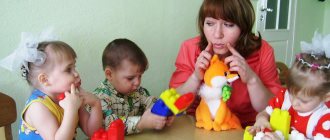The magical age from two to five flies by quickly, when parents are thrilled by any new word mastered by their home linguist. Baby babble seems richer and richer than classic adult speech. And the parents themselves are not averse to lisping with their child in his bizarre language, wittingly or unwittingly creating situations for the incorrect formation of speech and pronunciation skills.
Writing and pronunciation of the letter and sound L
Caution: physiological dyslalia
But by the age of four you need to be on your guard: the time for correct speech comes, and the baby simply does not know how to pronounce some sounds. And if you leave it to chance, and don’t teach him to speak correctly in time, you can make your child the subject of mockery and ridicule for the rest of his life. And he will probably have problems with spelling. Along with the difficult consonant “R”, many children do not know how to pronounce the letter “L”.
This speech defect is called physiological dyslalia in speech therapy and is quite common among children from four to six years old.
Types of pronunciation disorders
Over time, many people themselves can learn to speak correctly. This is how a child can distort the letter "L".
- The baby does not hear this sound and completely misses it: instead of “ruler” he says “frost”.
- “L” is replaced by the sound “U” or “V”: “spoon” - “oozhka”; "Larissa" - "Varisa". At the same time, children try to pronounce “L” not with the tip of their tongue, but with their lips
- Instead of “L” it is pronounced “Y”: “hammer” - “myotok”
- The child confuses the hard and soft letter “L”.
Before contacting a speech therapist, it is useful for parents to become familiar with the rules of pronunciation of the sound L and teach them to their child. Perhaps after home lessons he will begin to say this sound correctly.
Correct articulation of the L sound
- The lips should be stretched into a smile and clenched teeth should be shown: this is necessary so that the hard sound “L” does not turn into “V” or soften.
- The tip of the tongue can occupy the following positions: it presses on the upper teeth; it can be pressed against the upper alveoli; it can rest against the gap between the teeth.
- The air is pushed out under pressure through the holes on the sides of the tongue.
- It is important that the tongue does not rest against the sides of the teeth, allowing air to pass through.
Classes should be conducted in this order
Before you start practicing, you need to practice pronouncing this sound according to all the rules in front of a mirror. It is likely that the child received a speech defect as a result of the incorrect pronunciation of the letter “L” by someone in the family.
Types of lambdacism
Before moving on to sound production, you need to find out what type of violation of this sound pronunciation is.
| Labiolabial [l] | In this case, the lips are involved in sound production and instead of [l] we hear [u]: “uampa”, uapata, “ushka”, etc. |
| Labial-dental [l] | The production of sound involves the lips, which come into contact with the teeth and we hear [v], while the tongue does not rise behind the upper teeth, but remains lying in the middle of the oral cavity. We hear “vapa” - instead of “paw”, “votka” - instead of “boat”, “shva”, instead of “walked”, etc. |
| Reduced [l] | The case when [l] is replaced by short [th]. The tip of the tongue does not reach the upper teeth, but remains in the middle of the oral cavity, its middle back rises upward. As a result: “yapsha”, “yizhi”, “yuk”. |
| Interdental pronunciation | The tip of the tongue falls out between the teeth, this appearance is most consistent with correct articulation, while softening a little. |
| Softened pronunciation | This is when instead of a hard [l], we hear a soft [l]. In this case, the back of the tongue rises to the palate; this often occurs due to the fact that the tongue is in hypertonicity. The sound [l'] is most often replaced with [th]. |
Pronunciation of the hard sound L
- We start with a wide smile, which the child demonstrates, exposing clenched teeth, as if pressing a bell button, with the tip of his tongue he presses hard on the front teeth or alveoli, and begins to hum like a steam locomotive. There should be a hard “L” sound - it is very rarely possible to teach this to a child right away. Most often the sound is soft.
Sessions with a speech therapist are indicated for severe pronunciation problems - Let's try pronunciation with the tongue clamped between the teeth. The baby smiles widely, showing all his teeth. Then he “catches the mouse” - he bites the tip of his tongue with his teeth. He begins to breathe like a dog that is very hot. The air should pass along the sides of the tongue, not through the nose! To control this, you need to pinch your nose and watch how the air passes. With his tongue held tight, he hums in a bass voice, like a big steamship: “y-y-y” or “a-a-a.” After this, you can rest and put your tongue on your lower lip, continuing to say “ah-ah.” After we have managed to teach the baby to pronounce the letter “L” in such a simplified way, we reinforce the resulting syllable “La” by humming any melody: “la-la-la.”
- We repeatedly train the resulting sound in syllables: LA-LO-LU-LY-LU
- The child reinforces the interdental pronunciation of the hard “L” by repeating a series of words containing this sound. LAMP – SHOVEL – SPOON – ELK – HORSE – ALOE – WELL – LAD – STRAW – YULA – SAW – SQUIRREL – WOLF – TABLE – CHAIR – BICYCLE.
- When interdental pronunciation is mastered, you can suggest pronouncing the sound “L” while holding your tongue behind your teeth.
Exercises for pronunciation of the sound L
After fixing the hard “L” with a series of words, we continue to ensure that the child clearly pronounces all sounds, correct and remind him how to correctly pronounce this particular letter.
Practical skills for making sounds [R] and [L]
Mishulina Larisa Vladimirovna
Practical skills for making sounds [R] and [L]
Often, if the child does not have chronic diseases, pathologies in the development of the organs of the speech apparatus (tongue, soft and hard palate, lips, disorders in the functioning of the nervous system, adults at home can help the baby master this or that sound . In this case, you only need to know the order actions necessary to produce missing or distorted sound .
• Firstly, the main thing parents should start with is strengthening articulatory motor skills. This is achieved through various exercises, of which the literature provides many.
• Secondly, this is the production itself or clarification of the sound . Each sound has its own technique.
• The next stage will be to consolidate the sound first in syllables , then in words.
• After the child successfully pronounces a sound in words , he is offered tasks for differentiation (discrimination)
oppositional
sounds .
• Next comes the stage of memorizing nursery rhymes, tongue twisters, riddles, poems with a set sound .
• And finally, we fix the sound in speech : telling fairy tales, composing stories.
Most often when pronouncing the sound “L”
the following disadvantages are encountered:
the sound is completely absent , replaced by others - L, V, U, I. (bench - “lyavka”
,
“yavka”
).
Due to the fact that pronouncing this sound requires the upper position of the tongue, you need to find out whether the child can lift it up.
In order for the tongue to clearly hold the desired position, we offer the following exercises designed to strengthen the muscles of the tongue:
1. "Sting"
– show a narrow tongue
2. "Sting"
-
“Shoulder”
- show either a narrow or a wide tongue.
3. "Swing"
- the tongue touches alternately the lower and upper lips.
4. "Pendulum"
- the end of the tongue turns into the corners of the lips.
5. “Let’s punish the naughty tongue”
- stick out your tongue, pat it with your lips (five-five-five, so that it becomes wide.
6. "The tongue is sleeping"
- lightly bite the end of your protruding tongue, opening and closing your mouth, lips and tongue relaxed and motionless.
After you notice that the child can easily cope with the proposed exercises, you can proceed directly to making the sound “L”
.
The first method of invoking L: the spread tongue lies motionless between the teeth ( “The tongue is sleeping”
, mom suggests singing AAA and, without stopping, bite the tip of your tongue, continuing to sing the same
sound - it turned out ALL. I would like to warn you that at this stage there is no need to ask the child what sound he made .
This can only be done after repeating the exercise many times, when everything works out. The second way of staging : sing YYYYY, while biting your wide tongue. This exercise is shown to the child silently so that the sound L is not heard , otherwise he will pronounce it with the usual distortion.
The sound obtained with these techniques is first fixed in closed syllables (AL, IL, OL, UL)
;
further - between vowel sounds (ALA, ILA, ULO., then in open syllables (LA-LA, LO-LO, LU-LU, LA-LU, LO-LU, etc.)
.
Next, as we said earlier, comes the consolidation of sound in words :
• where the sound L is at the end of the word: rear, donkey, chair, roll, glass, etc.
• where the sound L is at the beginning of the word: skis, bast, boat, puddle, horse, etc.
• where the sound L is in the middle of the word: fang, class, glory, eyes, flea, etc.
Next, you begin to memorize simple poems, nursery rhymes, and riddles with your child, in which the sound L . This will automate the resulting sound and introduce it into speech .
Let's learn how to teach a child to say the letter "r"
at home.
This is a very difficult sound , and many children begin to master it last. The speech apparatus, vibration and amplitude of the tongue must be sharp, and the root of the tongue and frenulum must be strong, holding the sound . Thanks to the ability of the tongue to relax, vibration occurs during a strong exhalation.
There are several options for distorting this sound by children :
the sound is between vowels, for example in the words: barn, garage, sparrow;
“fish” correctly
,
"hand"
;
the sound can be pronounced recognizable, but not typical for the norms of the Russian language (this is typical for a bilingual child)
;
the pronunciation of the sound is not firm , there is grazing (as in French)
or too strong vibration
(it is not the tip of the tongue that vibrates, but the soft palate or its small tongue)
;
single-stroke sound "r"
has similarities with the English
“r” (the tip of the tongue does not vibrate, but hits the hard palate only once)
;
the child pronounces the sound “in the nose”
as if he has a runny nose.
the baby's pronunciation . You need to ask the child to “growl”
, that is, pronounce
the sound separately , outside the syllable or word. Afterwards he must repeat the words: grass, king, sparrow and others.
If a single sound does not work , you should select exercises and teach how to pronounce the sound “r”
.
If “growls”
well, but does not pronounce words as part of the words,
practice the correct pronunciation of the sound in different syllables .
Causes of pronunciation problems
At what age should a child pronounce the letter “r”
? By the age of six. The child’s articulatory apparatus must be sufficiently trained. But there are certain reasons for such a violation:
1. Short hyoid frenulum (membrane under the tongue)
.
The tongue frenulum should stretch to 8 mm by age six. sound may occur .
Special exercises will help you stretch it. 2. Sound pronunciation . The child confuses whistling and hissing sounds . Over time, he may begin to confuse the sound “r”
.
If instead of “r”
he pronounces
“l”
, the situation is corrected more easily.
The position of the tongue when pronouncing these sounds is similar . If a child replaces the sound “R”
with other
sounds , it will be more difficult to change the situation. But in both cases he hears the necessary sound . If the child misses it altogether, it is possible that his phonemic perception of sound .
3. Impairments in phonemic hearing. We can say that the hearing aid does not fully perceive individual sounds . Phonemic hearing develops at 4-5 years of age. But even earlier, one can suspect that the baby hears sounds differently . sounds are substituted or omitted . It is necessary to take the child to a neurologist and speech therapist as soon as possible. Possible causes of this pathology: damage to the central nervous system, a problem with the adenoids, previous otitis media.
4. Tone of the tongue, cheeks, lips. Missing sounds is also possible due to insufficient development of speech muscles, which may be inactive (hypotonicity)
or too tense
(hypertonicity)
.
5. Behavioral disorder. Mastering the required sound requires some effort. It is difficult to correct the situation if the child has attention deficit hyperactivity disorder.
6. Throat "r"
.
The child replaces the difficult-to-pronounce sound with a simpler version (vibration occurs due to the laryngeal uvula)
. It is difficult to correct the problem; retraining is necessary under the supervision of a speech therapist.
In all of the above cases, it is necessary to correctly determine the reason for the child’s incorrect pronunciation of the sound “r”
.
Let's look at how to teach a child to pronounce the letter "r"
without a speech therapist.
You should start with articulation gymnastics.
All exercises for the development of articulation are designed to solve the following problems:
develop tongue mobility (you need to learn to make your tongue wide, narrow, lift it, move it away)
;
develop lip mobility;
develop the skill of holding the lower jaw in a certain position.
Be sure to warm up first, otherwise the exercises will be ineffective!
Articulation gymnastics
Exercises for the letter "r"
for children should be carried out in front of a mirror. Or let the child repeat them after adults. The training is done daily. The number of repetitions is 6-8 times.
Gymnastics should bring pleasure to the child, interest him, but not tire him.
If all the above exercises are easy, you should proceed to the next exercises. Let's look at how to put the letter "r"
child at home.
the sound “r” correctly
The following exercises are suitable for independent daily speech training:
1. The mouth opens, the tip of the tongue is pressed against the base of the upper teeth, the sound “d-d-d”
.
After a couple of seconds, the child, without interruption, should blow strongly on the tip of his tongue (pronounces “d-d-d”
while exhaling forcefully).
It is necessary to feel the vibration of the tongue and remember it. The articulation of "d"
is similar to the articulation of
"p"
.
2. You will need a speech therapy spatula, which is sold in specialized stores and pharmacies. They are made from hypoallergenic materials with the aroma of caramel, chocolate, and fruit. You need to use the device carefully but confidently. The child must pronounce the sound “zh”
and
gradually move the tongue to the base of the upper teeth. After a couple of seconds, a spatula is inserted under his tongue and they begin to rhythmically, but carefully, oscillate it left and right, creating vibration. The baby should blow strongly on his sound so that he feels the vibration.
3. The sound “z-za”
. In this case, the tongue is moved back as much as possible, a spatula is placed under it, and it is rhythmically moved left and right.
4. Pronounce “z-zi”
, the same manipulations are done with a spatula.
Trains a softer “r”
sound .
5. One of the effective exercises is “Motor”
.
A finger, a cotton swab or the same spatula is placed under the tongue pressed to the upper palate. The child forcefully pushes out a stream of air and says “ddd”
or
“zhzh”
.
The spatula makes oscillatory movements. The tongue is tense, the tip is relaxed, vibrating, the “engine”
has started.
6. Sound production from “Mushroom”
"R"
- an insidious
sound . It's difficult to automate. The child may growl, but the desired sound will be absent.
As soon as the child begins to make an independent “r”
, it is
gradually combined with vowels, consonants, successively brought to automatism, pronounced in syllables, words, sentences.
First we work through the sound “d”
,
“t”
in the syllables
“dra”
,
“dro”
,
“tra”
,
“tru”
and so on.
It is easier for a child to start from these sounds .
Gradually the initial consonant is removed, leaving “ra”
,"RU".
The reverse syllables “ar”
,
“or”
.
Variations are scrolled to the point of automaticity. They don't move forward until these sounds .
Then they move on to words. Start with those that start with "r"
,
“tr”
(fish, grass, child, then move on to words in which
“p”
is in the middle and end
(cow, teremok)
.
At the same time, they learn to distinguish between soft and hard “r”
. To make it soft, the tongue is pressed harder against the palate, closer to the teeth. For the hard one, make it more relaxed and place it deeper.
Each sound its own automation duration. occurs faster for whistling , longer for hissing sounds, but “r”
It is the most difficult to automate and will take the longest time. Parents and children need patience, time, and gentle persistence.
Articulation gymnastics
Exercises that increase the mobility of the tongue and lips will help you quickly learn how to correctly pronounce various sounds, and this applies not only to one letter “L”.
L sound articulation profile
- Smile. It is important to remember that you must pronounce the sound “L” with a wide smile. We try to teach the baby to smile from ear to ear with his mouth closed and hold the resulting grimace while counting to 10.
- Breeze. This exercise can teach a child to exhale air correctly while pronouncing the sound “L”. We bite the tongue and blow with all our might through the side holes between the teeth, simulating a hurricane. We don’t puff out our cheeks.
- Yummy. We lick our lips with our tongue in a circular motion; With this exercise, the child trains his tongue to correctly pronounce various sounds.
- Horse. Smiling widely and showing your teeth, imitate the clicking of a horse, first loudly, then more and more quietly, leaving the lower jaw motionless.
Speech therapy exercises for L articulation - Steamboat. We hum in a bass voice, like a steamboat, with the tip of the tongue remaining behind the teeth and the back raised to the sky: “y-y-y”
- Comb: close your teeth and push your tongue between them, as if combing it. This exercise can teach you to quickly take the tongue into the desired position when pronouncing the difficult sound “L”
- Swing your tongue in your mouth, resting it first on the right cheek, then on the left.
Today, researchers have proven that fine motor skills of the hands are directly related to speech, so modeling, finger games, and small toys for a baby are necessary to learn to speak correctly.
The development of hand motor skills helps develop speech.
If, after many efforts, the child still cannot pronounce the letter “L” correctly, it is necessary to contact a speech therapist.
Perhaps it is a malocclusion, a neurological disease, or stress. It is important to remember that the age from 4 to 6 years is the most favorable for learning correct speech; later it will be necessary to eliminate the ingrained skill, and this is more difficult to do. leave a comment
Gymnastics for children's language
One of the main roles in the formation of the correct pronunciation of sounds and in the development of a child’s speech is played by the “tuning” of his articulatory apparatus. To do this, you can use the following exercises:
- “ Who lives in the house? " First the tongue sticks out, and then hides back. At the beginning, the exercise is done slowly, and then the pace accelerates;
- " Watch ". The tongue sticks out and moves from left to right, like a clock pendulum;
- " Swing ". The tongue protrudes, its tip bends and so it either rises or falls;
- " Horse ". You need to click the tongue, pressing it to the sky;
- " We're painting the fence ." Use the tip of the tongue to stroke the inside of the teeth up and down;
- " We're driving in circles ." The tongue makes circular movements along the inner surface of the lips.
Always remember that poor, insufficient development of a child’s speech affects his character (he becomes withdrawn, irritable), his mental development, and his ability to quickly and easily master reading and writing.
You can download the speech therapy alphabet for the development of a child’s speech at the link:
You can find various materials for child development in the section of our parents’ club of the same name by following the link provided.
Follow the updates on the website roditeli.club, as well as on pages on social networks, the albums of which contain even more materials for development:
- Tummy Parents Club on VKontakte;
- Tummy Parents Club on Facebook.







